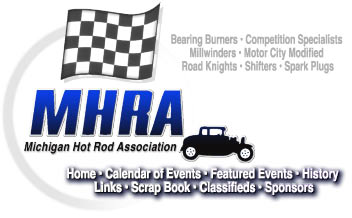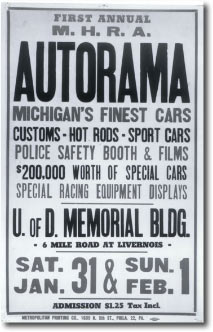 |
 |
 |
 |
| MHRA History |
Added 1/06: "MHRA Over The Years" by Paul Curtis
|
Bob Larivee, Sr. & The MHRA
Listed below, is an excerpt from "Showtime" The Story of the International Championship Auto Shows and the Hot Rod/Custom Car World, A Twenty-Year History by Michael Sheridan and Sam Bushala.
Copyright 1980 by Promotional Displays, Inc.The Midwest came alive in 1951 with the formation of the Michigan Hot Rod Association, which included twenty-two clubs and four hundred members at its highest point. Street racing had become a problem for all legitimate car clubs, and the MHRA wanted to organize clubs and provide a safe place to race. The goal was to build and operate a first-class racing facility of their own, but financing was nonexistent. By cooperating with local law enforcement agencies, the MHRA had public streets blocked off to traffic, and the first races were held there.
| In 1953
the MHRA held its first Autorama car show at the
University of Detroit Field House. The efforts of all the
club members in producing and promoting the show made it
a success. Right from the start, the MHRA proved that
funds could be raised for a drag strip by holding a
quality auto show. As the Detroit Autorama grew in size,
it moved from the University of Detroit Field House to
the State Fairgrounds to the Artillery Armory and back to
the Fairgrounds.
In 1956 the MHRA decided to hire a professional promoter in order to increase the show in size and stature. Don Ridler, a local promoter specializing in band and sporting events, was contracted to handle the next Autorama. Under Ridler's direction, the Detroit show developed quickly. By adding bands to the show and scoring with major publicity stories in the news media, Ridler quickly succeeded in developing the Detroit show, generating funds needed to build the dream raceway in New Baltimore, Michigan. Bob Larivee, a member of the board of MHRA, was selected to manage the new racing facility. All the members gave whatever free time they had to grade the raceway and construct the building that housed the equipment and announcer's tower. MHRA secured loans to pay for the concrete racing surface, and Michigan's first official dragstrip was reality. This would prove to be only a starting point for Bob Larivee. He would go on to play the most dominant role in conceptualizing and developing the International Championship Auto Shows series. Larivee's love for the automobile started with his participation in the Soap Box Derby in 1946 and continued on to his early racing days in an MG TD in SCCA events and road rallies to circle track racing. He was always the driver in several racing partnerships, including one with his friend and Soap Box Derby competitor, Ron Ekholm. In addition to racing, being a board member in MHRA, a president of MMAC (MHRA membership club), and managing the race track, Larivee worked in the family sign painting business, attended art school. and raised a family of four children in Harper Woods, Michigan, a suburb of Detroit. He also found time to work on the Autorama show, becoming good friends with Ridler and learning the business of show promotion. In 1959 Larivee and his brother Marvin, an attorney, decided to produce auto shows in other cities and they founded Promotions, Inc.. Spurred on by the success of the Detroit Autorama, Larivee felt he could provide other cities with quality rod and custom shows where local clubs had neither the means nor the experience to hold a show themselves. Promotions, Inc., would help the local club, and cover the costs of the show without risk. Larivee was an auto enthusiast first, a businessman second. He believed that strong and solvent clubs would enable the hot rod sport to grow.
|
 The 1st Detroit AutoRama Event Photo: Thanks to Championship Auto Shows, Inc.
|
Copyright 2006 MHRA & Promotions, Inc.